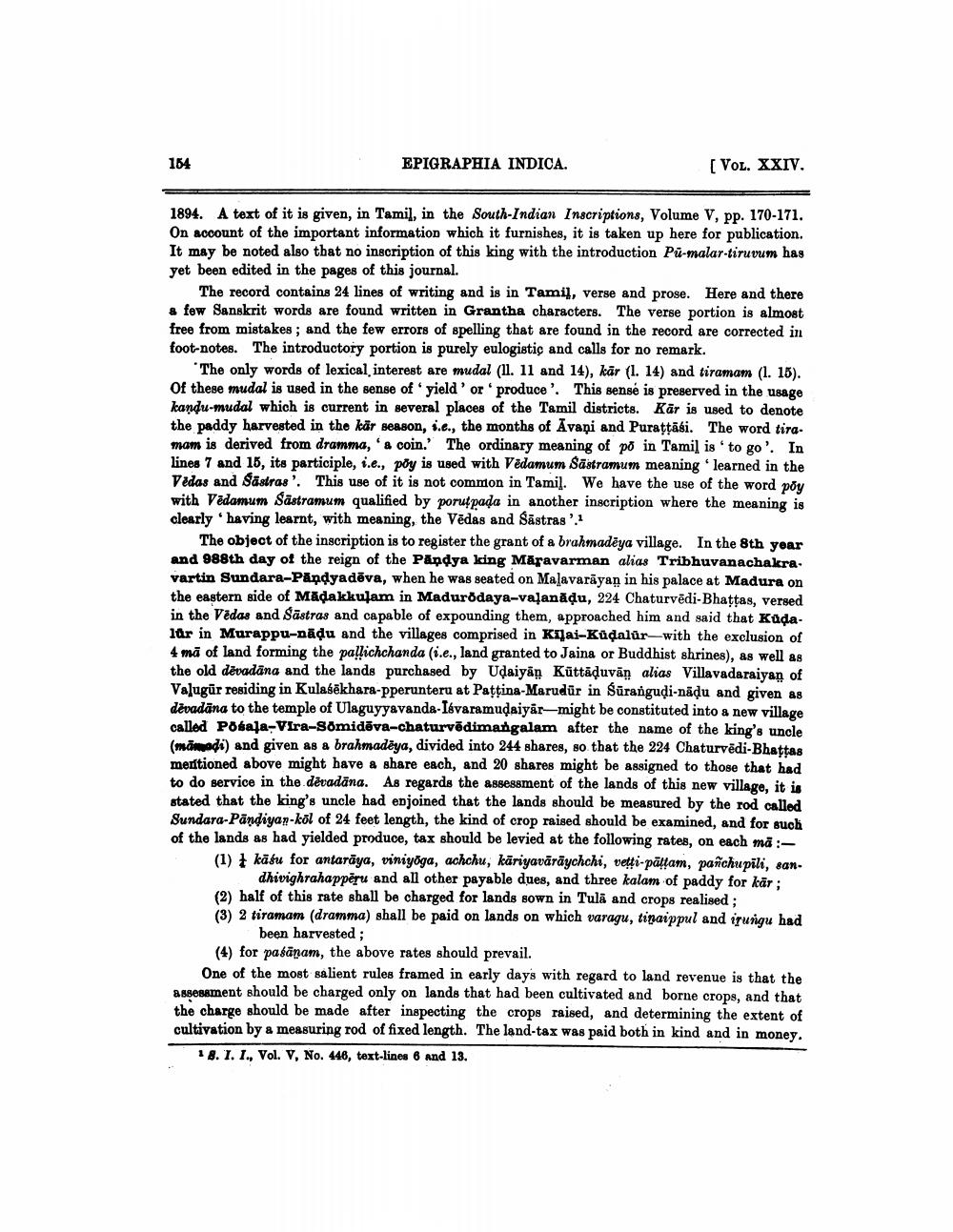________________
164
EPIGRAPHIA INDICA.
[Vol. XXIV.
1894. A text of it is given, in Tamil, in the South Indian Inscriptions, Volume V, pp. 170-171. On account of the important information which it furnishes, it is taken up here for publication. It may be noted also that no inscription of this king with the introduction Pů-malar-tiruvum has yet been edited in the pages of this journal.
The record contains 24 lines of writing and is in Tamil, verse and prose. Here and there a few Sanskrit words are found written in Grantha characters. The verse portion is almost free from mistakes; and the few errors of spelling that are found in the record are corrected in foot-notes. The introductory portion is purely eulogistic and calls for no remark.
The only words of lexical interest are mudal (11. 11 and 14), kar (1. 14) and tiramam (1. 15). Of these mudal is used in the sense of yield ' or 'produce'. This sense is preserved in the usage kandu-mudal which is current in several places of the Tamil districts. Kār is used to denote the paddy harvested in the kär season, s.c., the months of Avani and Purattasi. The word tira. mam is derived from dramma, 'a coin.' The ordinary meaning of po in Tamil is to go'. In lines 7 and 18, its participle, i.e., poy is used with Vēdamum Sastramum meaning learned in the Vedas and Sastras'. This use of it is not common in Tamil. We have the use of the word poy with Vēdamum Sastramum qualified by porutpada in another inscription where the meaning is clearly having learnt, with meaning, the Vēdas and Sastras '.1
The object of the inscription is to register the grant of a brahmadėya village. In the 8th year and 988th day of the reign of the Pandya king Māravarman alias Tribhuvanachakra. vartin Sundara-Pāņdyadēva, when he was seated on Malavarāyan in his palace at Madura on the eastern side of Madakkulam in Madurodaya-valanādu, 224 Chaturvēdi-Bhattas, versed in the Vedas and Sāstras and capable of expounding them, approached him and said that Kudalar in Murappu-nādu and the villages comprised in Kilai-Kudalur-with the exclusion of 4 mā of land forming the pallichchanda (i.e., land granted to Jaina or Buddhist shrines), as well as the old dévadāna and the lands purchased by Udaiyan Küttāduvān alias Villavadaraiyan of Valugur residing in Kulasēkhara-pperunteru at Pattina-Marudūr in Sūranguļi-nādu and given as devadāna to the temple of Ulaguyyavanda-Isvaramudaiyar-might be constituted into a new village called Potala-Vira-Somidēva-chaturvēdimangalam after the name of the king's uncle (māmadi) and given as a brahmadēya, divided into 244 shares, so that the 224 Chaturvēdi-Bhattas mentioned above might have & share each, and 20 shares might be assigned to those that had to do service in the devadāna. As regards the assessment of the lands of this new village, it is stated that the king's uncle had enjoined that the lands should be measured by the rod called Sundara-Pāndiyan-kol of 24 feet length, the kind of crop raised should be examined, and for such of the lands as had yielded produce, tax should be levied at the following rates, on each mä:(1) + kādu for antarāya, viniyoga, achchu, kāriyavāräychchi, vefti-päffam, pafichupili, san
dhivighrahappēru and all other payable dues, and three kalam of paddy for kār; (2) half of this rate shall be charged for lands sown in Tula and crops realised ; (3) 2 tiramam (dramma) shall be paid on lands on which varagu, tipaippul and irurgu had
been harvested ; (4) for pasānam, the above rates should prevail.
One of the most salient rules framed in early days with regard to land revenue is that the assessment should be charged only on lands that had been cultivated and borne crops, and that the charge should be made after inspecting the crops raised, and determining the extent of cultivation by a measuring rod of fixed length. The land-tax was paid both in kind and in money.
18. 1. 1., Vol. V, No. 446, text-lines 6 and 13.




